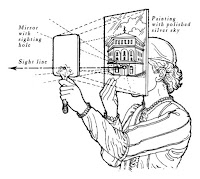AUGMENTED MEMORY in an artist’s
atelier / AR installation, Parthenon -Frieze
Hall Budapest [2012]
"The only true voyage of discovery (…) would be not to visit strange lands but to possess other eyes”Marcel Proust *
Time and memory became the main topics of an experiment based on Augmented Reality. The installation was part of a PhD research project into the artistic usage and possibilities of immersive and augmented virtual reality. Using Augmented Reality, the past and the present placed together, and time passed became visible.
Would it be possible to
recall a place with interactive technology? Could virtual systems take us
somewhere else in time? Alongside these questions, the main idea was to show
the layers of time in connection with technology. Furthermore, the experience
intended to investigate the possibilities to observe a space in relation to
time and history.
 |
| [Fig.1.] |
 |
| [Fig.2.] |
From the technological
side, AR seemed to be the best solution for projecting the images in their
original positions. Luckily the relief running around the wall served as a
perfect pattern showing the appropriate size and the actual positions of the
captures. After linking the photos to the AR markers, they just needed to find
their original position in the space. Supervisor of the project, Dr. Zoltán
Szegedy-Maszák, head of the Doctoral School, offered his assistance to develop
the idea. Since he had made several AR based artworks in the early on in the
development of Augmented Reality, he helped to modify his own software for the
new parameters.
When visitors entered the space, they saw the empty walls with AR markers
placed around as well as the monitor on the top of the sculptor table. The
classical interior with the geometrical black and white AR markers strongly
contrasted each other. This particular exhibition place is known for showing
more ‘classical’ media, in that sense, high-tech equipment on the top of a
sculptor table can be also considered as a different statement. The copy of the
master’s table served as a tripod. A monitor with a webcam on its back was
visualized the AR experiments, while a small laptop with the software was
hidden inside the table. The camera and the tripod handle invited the visitors
to move the screen; when the camera captured the AR markers, the images
appeared. Pictures with different transparency sometimes make the past, or the
present more visible. The physical space was filled with digital information
and on the screen they became one. Moving the screen around the space enabled
visitors to observe the room in different periods of time, and turning the
monitor 360° around, made it possible to experience the reconstruction of the
whole space. The reaction of the audience varied. Some visitors were grateful
about recalling the shine of each period, and considered the installation as a
kind of interface that displays cultural heritage. Others enjoyed watching
people walking in the background, so they got a more merged view. The result
was a feeling close to time travel. Some visitors even asked to develop the
work in a way that they can walk in the picture while they also can see the
image. They wanted to be inside the screen, what really is a step to consider
next.
While we augment the space, the project proved that if the supplements
have something to do with the real space, if the two have a strong tie, we
might believe that they are one. Archive pictures can give us information from
previous times, but if we can interact with them, or step inside them, maybe it
will lead us toward a new kind of relation with time.
Acknowledgement
The installation was
supported by the EU as part as the TÁMOP project. The work could not have come
into existence without the help of the supervisor Dr. habil DLA Zoltán
Szegedy-Maszák. Thanks goes out to the Stróbl family’s generosity for sharing
their archive. The project leader is also really grateful and would like to
thank to the AR Lab for their support, especially to Wim van Eck for the
technical advice, and Yolande Kolstee for the individual assistance.
Supervisor of the project Dr. habil DLA Zoltán
Szegedy-Maszák: www.szmz.hu
* Marcel Proust: Remembrance of Things Past
[1913—1927] Vol. V, The Captive [1923], ch. II "The Verdurins Quarrel
with M. de Charlus" (1929 C. K. Scott Moncrieff translation)
[Fig.2.] Filippo Brunelleschi (1377-1446) proving the
theory of linear perspective with a mirror device 15th century
Kibővített Emlékezet
Parthenón-fríz terem Budapest
[2012]
Parthenón-fríz terem Budapest
[2012]
„Az egyetlen igazi utazás,
… nem az lenne, ha új vidékek felé törnénk, hanem a másféle látás, ha valahogy
más szemével, ha száz más szemlélő szemével láthatnánk …” * Marcel Proust
Valós és
virtuális világ határai elmosódnak, a Kibővített Emlékezet [2012] interaktív
videó installáció arra teszek kísérletet, hogy ezt a folyamatos az idő és az
emlékezet szempontjából is megvizsgálja, azaz egymásra helyezzem a két
területet. A kutatás az immerzív és
augmentált virtuális valóságok lehetőségeit vizsgálja a képzőművészetben.
A projekt
megvalósítására a budapesti Epreskert Parthenón-fríz termében került sor. E
térben alkotott egykor Stróbl Alajos szobrász, aki számos híres magyar
személyiség portréját készítette el, ott, az Epreskerti műteremben. Kutatásom során számos archív felvételt
találtam, melyek - bár különböző időben, de nagyjából - az 1900-as évek elejéről
származnak. A teremben készült fotókat kódokhoz rendeltem, és azokat eredeti
helyükre pozícionáltam. Egy monitoron keresztül így lehetőség nyílt, - ha csak
elméleti síkon is, a tér különböző időben való szemlélésére. Az interfész
forgatásával lehetőség nyílt megmutatni a tér több mint száz évvel ezelőtti
állapotát.
Az Augmented
Reality (AR) kibővített tér szoftver kódok segítségével ad hozzá a látványhoz,
megjeleníthet két vagy háromdimenziós alakzatokat, de akár animációt vagy
hangokat is.
Munkámban a
szoftver felhasználásával egymásra csúsztatom az idősíkokat, a valódi teret
hozzáadott információkkal egészítve ki.
*
[1.kép] Az átrium
a szökőkúttal 1895. (archív fotó a Stróbl család engedélyével)
[2.kép] Filippo Brunelleschi (1377-1446)
a lineáris perspektíva bizonyítása tükör segítségével. 15. század.

.jpg)

.jpg)
.jpg)
.jpg)
.jpg)